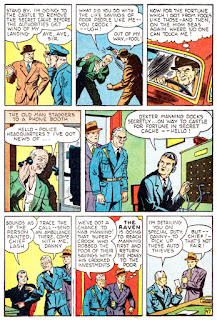Dexter Manning is a 1941 millionaire, when a million was a real chunk of change. Dexter can afford a castle, a manservant, and yet keeps his wealth in cash. He plans to abscond with the swag but first he gives his manservant a .45 caliber retirement plan. No wonder Dexter has a bad reputation.
Enter the Raven. Unlike many costumed heroes with no superpowers, Raven is not a wealthy playboy. This so-called Robin Hood is a detective both masked and unmasked, who goes after evil one-percenters.
The story is from Ace’s Four Favorites #1 (1941), and is credited to Adolphe Barreaux. Barreaux is also known for his sexy Sally the Sleuth stories from Spicy Detective, one of DC's line of sexy pulp magazines. Barreaux is one of the earliest comic book artists, having done the Sally strip (and I do mean strip, since the girl could not keep her clothes on) since 1934. The Spicy line was kept separate from DC, and Barreaux ran his own art studio. Later he was editor of the Trojan line of comic books, yet another DC side business.












8 comments:
Very nice story!
I'd say is a cliffhanger movie serial in four colors. I really like the stairway in page 9.
We have a modern Zorro here. That is good, for El Zorro (like Robin Hood) is tolerated as a relic of the past - But who wants a Zorro, right now?
I suspect The Raven is the only Golden Age hero operating in 1940's America, who's interested in a fair redistribution of wealth.
No wonder Chief Lash wants to nail him. Car thieves, sure... they're the real problem in modern society.
I really like Sally the Sleuth, by the way.
Interesting that the folks who ran DC turned to someone who had been involved with Spicy Detective when they wanted a comic-book line producing material that they likewise did not want connected with DC! (The Trojan comic books were horror or overt crime comics.)
(I wish that someone could and would produce a fairly thorough history of the practical relationships between mainstream comic books and transgressive publications. But much of that history is probably forever lost to us.)
Autogyros are a fine thing in pulp fiction, in movie serials, and in comic book stories. Gyroscopes, on the other hand, are something to figure more in the advertisements. As get-away devices, they will work only until one's pursuers stop laughing.
Sergeant Dartin doesn't seem to mention that Bix and Vick were captured by the Raven. Nor does he seem concerned that they might mention it.
What does the Chief do with loot if he gets his hands on it before the Raven? Is there some sort of tax on victimization in that town?
Well, that wasn't at all derivative. And shouldn't the Raven's disguise include something besides Danny Dartin's regular purple business suit? But here's the sticker for me; help me out here, Pappy. The Chief says he's "personally going on the Manning case - for two reasons." Two, he says. He follows that with three statements:
* "I'm positive that the Raven will show up!! He couldn't resist this[.]"
* "So I'll capture both the Raven and Manning and show everyone I'm still top man on the force[.]"
* "And I'm going to set a little trap for the Raven when he shows up[.]"
So, uh, what are the two reasons?
Daniel, I'm with you; I am also interested in those businesses. Will Murray's "DC's Tangled Roots" in Comic Book Marketplace #53 (1997), is one of my favorite articles about the origins of DC Comics. DC was born from the sleaziest of sleazy pulps, and it, rather than porn, gave the publishers respectability and wealth. An American success story. But they had that Jekyll-Hyde side when they put out the more objectionable comics to go along with their A-list superhero books and licensed titles.
J D, I'm guessing, but you might have seen the Walt Disney Zorro television series in Italy. It was my favorite show when it was popular in the late fifties. In those days when no one had even heard of graffiti, there was a rash of Z's being chalked and painted on walls and buildings.
I liked Zorro like I liked Batman...the non-super heroes, who operated while in disguise, outwitting their enemies with athleticism and smarts, instead of super muscles and unrealistic powers. I thought Zorro and Batman could really exist, whereas Superman couldn't. I get the feeling that was the intent of this Raven story, also.
Ryan, gee, you're asking me? You obviously read the story much closer than I, who didn't pick up on the Chief's bumble. Maybe making three declarative statements after setting out to give two reasons means he was lousy at math.
Guy Williams was a star for us kids of the early 70s. In B/W, of course.
The Raven was the comic book version of the publisher's pulp hero the Moon Man. Same set up: young police detective secretly operates as a costumed thief going after unscrupulous wealthy and crooks and through an assistant distributes the money to the needy. His girlfriend is the chief's daughter. His partner has vowed to bring the heroic crook to justice.
Post a Comment